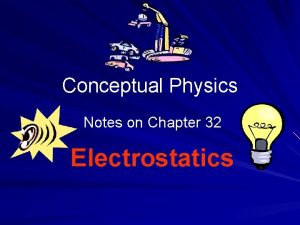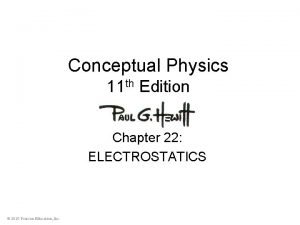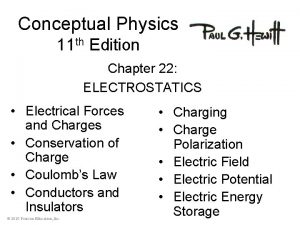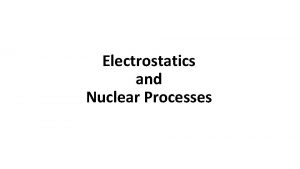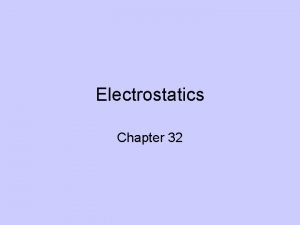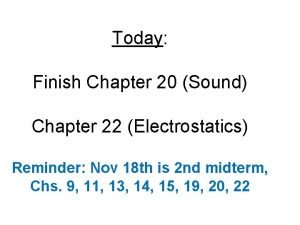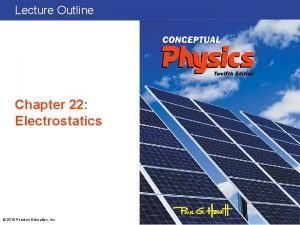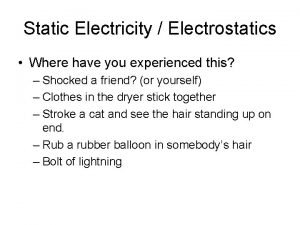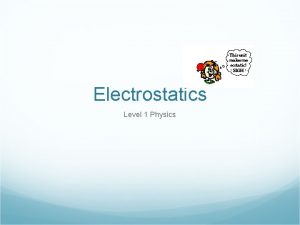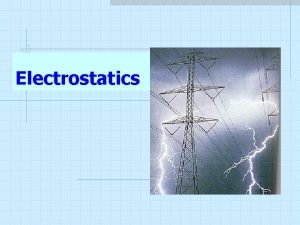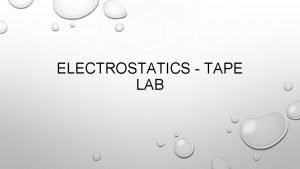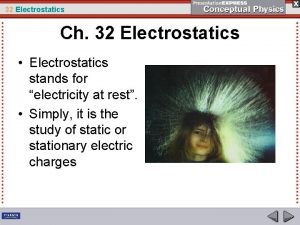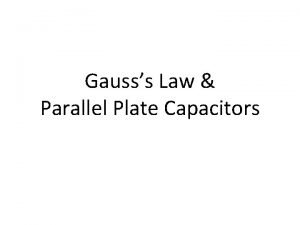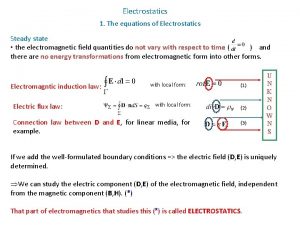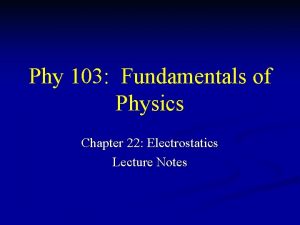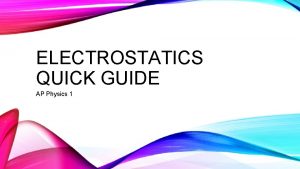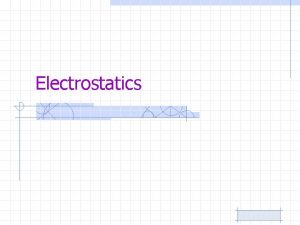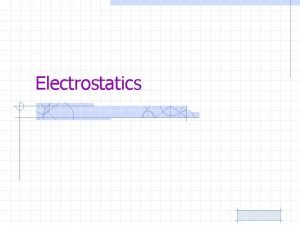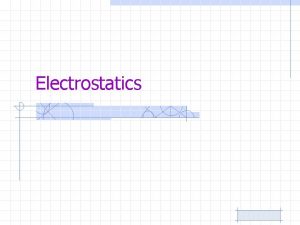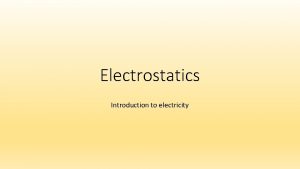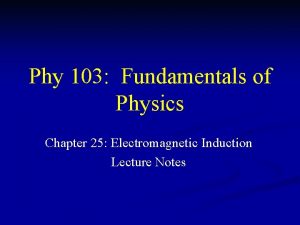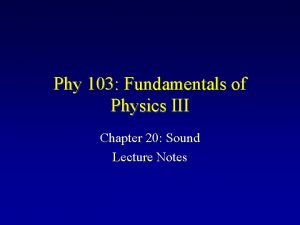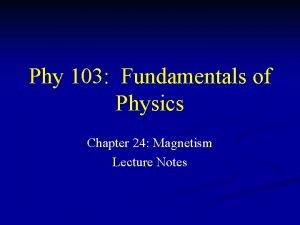Phy 103 Fundamentals of Physics Chapter 22 Electrostatics















- Slides: 15

Phy 103: Fundamentals of Physics Chapter 22: Electrostatics Lecture Notes

Electric charge n n n The fundamental electrical property to which the mutual attractions or repulsions between electrons or protons (in the atom) is attributed. Units of charge are called coulombs (C) Two types (called polarity) n n n Like charges repel n n n Negative-negative Positive-positive Opposite charges attract n n Positive (e. g. protons) Negative (e. g. electrons) Positive-negative The attraction-repulsion between charges is called electric force

Electric Charge Tidbits n Electric charge is “quantized” n n Electric charge has a smallest value that occurs in nature a single “packet” of charge The smallest quantity of electric charge is called a quantum of charge n n an electron has a quantum of negative electric charge (-e) a proton has a quantum of positive electric charge (+e) 1 quantum of electric charge, e, has a value of 1. 6 x 10 -19 C Conservation of Electric Charge n n Electric charge is neither created nor destroyed The total electric charge before an interaction equals the total electric charge after the interaction

Electricity n n n Electricity is the movement (or flow) of electric charge Electricity is due to the presence of electric forces acting on charges (causing them to move) Electricity can be the movement of: n n electrons (in metals) ions (in fluids such as water or air) The rate of flow of electric charge is called electric current The SI units for electric current are amperes (A) n n 1 A is the flow of 1 coulomb of charge per second How many electrons is this (per second)?

Newton’s Laws (quick review) n What are Forces? n n n The pushes or pulls on things that cause changes in motion SI Units of force are called newtons (or N) Types of forces: n n n Contact (involves direct touching/contact) Non-contact (occurs without direct contact, across space) Newton’s 1 st Law: when no net force acts on something, its state of motion will remain unchanged Newton’s 2 st Law: a net force acts on something, its state of motion will change: Fnet = ma Newton’s 3 rd Law: forces always act in actionreaction pairs between 2 objects

Coulomb’s Law & Electric Force n n Describes the magnitude of electric force between 2 “point” charges Magnitude of electric force depends on n n Magnitude of the charges involved (q 1 & q 2) Distance between the charges, 1/d 2 (actually the distance squared!) n To calculate electric force: n The direction of the electric force depends on the polarity of the charges n n Opposite charges (attractive) Like charges (repel)

Charles Augustin de Coulomb (1736 -1806) n n Engineer by education Won prize for his work on the subject of friction Won prize for using calculus of variations to solve engineering problems Published 7 important papers on electricity & magnetism (between 1785 -1791), including: – – The law of attraction and repulsion The electric point charges Magnetic poles The distribution of electricity on the surface of charged bodies

The Electric Field n n n The ability of a charge to influence other charges in its vicinity its electric field The SI units for electric field are N/C The electric field is a vector property n n E field lines originate at + charges & terminate at - charges The direction of an electric field vector (at a point in space) is the direction of electric force that would be exerted by on a positive charge at that location + -

The Electric Field (cont. ) n The force (FE) exerted by an electric field on a charge (qo) placed in the field (E) is FE = qo. E n The direction of the electric force is: n n n The same direction as the field (for positive charge) The opposite direction as the field (for negative charge) Formal definition of electric field: n the electric force per unit charge that acts on a test charge at a point in space or E = FE/qo

Conductors & Insulators n n n Conductance is a physical property of matter Conductance describes the ability of a substance to conduct electricity (allow charge to flow through it) Electrically speaking, matter can be classified as n Conductors: allow electrons/charge to flow through them n n Insulators: do not readily conduct electric charge n n non-metals, most ceramics, plastics, pure water Semiconductors: under certain conditions conduct eleetric charge but not under other conditions n n metals, dissolved salts in water metalloids, some ceramics Superconductors: allow electric charge to flow without any material resistance n n superconduction occurs at very low temperatures (<100 K) certain ceramics and metal oxides

Charging n Charging is the process of generating excess electric charge n localizing regions of charge within a substance n n There are 2 types of Charging: n Charging by friction and contact n Electrons can be transferred from one material to another by simply touching. n Charging by induction n Redistribution of electric charges in and on objects caused by the electrical influence of a charged object close by but not in contact.

Work & Energy (review) n n n Work is a measure of mechanical output (movement) due to some effort (a force) Work = (Force Applied)*(Distance Traveled) Energy is the capacity to do work Energy comes in many forms: n n n Kinetic energy (energy of motion) Heat (energy that flows from hot to cold) Potential energy (energy due to position) n n n Gravitational Electrical Nuclear Chemical The SI Units of work & energy are Joules (J) n Other units include calories & kilowatt-hours (k. W. hr)

Electric Potential n A charge placed in an electric field has an associated electric potential energy (EPE) n n n EPE is essentially the work required to place the charge at that location EPE is the energy a charged object possesses by virtue of its location in an electric field The electric potential energy reflects the amount of work the electric field can perform on the charge if it is free to move it Electric potential is a charged object’s EPE divided by its charge or Electric potential = EPE/charge or V = EPE/q Units of electric potential are J/C (or volts)

Alessandro Volta (1745 -1827) Italian physicist & inventor n First person to isolate methane n Fascinated with electricity at an early age n Pioneered the field of electrochemistry n Constructed the first battery to produce electricity (called a voltaic pile) n

Capacitors n n an electrical device that stores electric charge and electrical potential energy in its simplest form a pair of parallel conducting plates separated by a small distance +q + - + - + n n E -q - Electric charge of opposite sign accumulates on face of each plate, establishing an electric field between the plates The electric field between the plates has a constant value (magnitude & direction)
 Chapter 32 conceptual physics
Chapter 32 conceptual physics Conceptual physics electrostatics
Conceptual physics electrostatics Conceptual physics chapter 22 electrostatics
Conceptual physics chapter 22 electrostatics Physics classroom electrostatics
Physics classroom electrostatics This is electricity at rest
This is electricity at rest Chapter 22 electrostatics
Chapter 22 electrostatics Chapter 22 electrostatics
Chapter 22 electrostatics Qxa=e
Qxa=e Electrostatics formula
Electrostatics formula Electrostatics conceptual questions
Electrostatics conceptual questions Net charge
Net charge Electrostatics sticky tape lab answers
Electrostatics sticky tape lab answers Electrostatics
Electrostatics Electrostatics
Electrostatics Facts about electrostatics
Facts about electrostatics Electrostatics
Electrostatics
